Introduction
A SWOT analysis is a powerful tool that allows businesses to assess their internal dynamics and external market conditions. It provides insights into a company's strengths, weaknesses, opportunities, and threats, enabling strategic decision-making and planning. By evaluating their distinct competencies and external factors like industry trends and economic shifts, organizations can fortify their market position and navigate the business landscape effectively.
In this article, we will explore the importance of SWOT analysis, step-by-step guidance for conducting one, and practical examples of how businesses have utilized this framework to maximize their opportunities and address potential challenges. By leveraging the insights from a SWOT analysis, businesses can generate actionable strategies that capitalize on their strengths, mitigate weaknesses, and drive sustainable growth and competitiveness in a dynamic and complex business environment.
What is SWOT Analysis?
A SWOT analysis serves as a comprehensive lens through which businesses can scrutinize both their internal dynamics and external market conditions. This tool delineates the strengths, or internal attributes that confer an advantage over rivals; weaknesses which point to areas that require improvement; opportunities that represent potential paths for growth; and threats, external challenges that could impede progress.
In essence, a SWOT framework guides an organization in evaluating its competitive stance and devising tactics to reinforce its market position. It encompasses an appraisal of the company's distinct competencies, such as superior talent, financial robustness, or advanced technology. Identifying these factors equips a business with the insights to fortify its strategic planning and decision-making.
Moreover, the external components of the SWOT analysis prompt a response to factors beyond a company's control, like economic shifts, industry trends, or labor market fluctuations. Organizations utilize this analysis to navigate the landscape effectively, capitalizing on openings and building contingency plans against potential risks.
For example, as companies deal with the transition of remote work environments towards 'Return to Office' strategies, a SWOT analysis could highlight technological infrastructure as a strength while revealing reliance on physical workspaces as a weakness. Similarly, collaborations, such as Vodafone's strategic partnership with Microsoft to leverage cutting-edge AI, can be seen as opportunities to solidify market presence, while an unforeseen event leading to worker shortages could emerge as a threat.
In practice, a SWOT analysis is not merely an exercise in listing qualities and conditions. It's a strategic blueprint for evolving a business in aspirational ways, as captured by the quote, 'What makes a company successful are its value drivers, such as revenue growth and customer satisfaction, which are central to shaping a company's strategy, operations, and financial outcomes. '
Through a deep dive into internal and external factors, a SWOT analysis empowers businesses with actionable strategies, channeling their core strengths and mitigating weaknesses, to keep them thriving in a dynamic and complex business environment.
Why Use SWOT Analysis in Business?
A comprehensive SWOT analysis not only spotlights an organization's internal capabilities—its distinct strengths and potential weaknesses—but also casts a light on the unique opportunities available for strategic market positioning. It underscores the importance of external factors and how a company can pivot to make the most of positive market trends or new tech advancements. For instance, adapting to omnichannel business strategies can unify various communication channels, providing a streamlined customer experience and capturing a wider audience—a direct opportunity emerging from technological progression and consumer behavior trends.
By meticulously evaluating and leveraging such opportunities, businesses sculpt a clear pathway to advancement and competitiveness in their respective industries.
Step-by-Step Guide to Conducting a SWOT Analysis
Enacting a SWOT Analysis involves a clear, step-by-step method to scrutinize both internal dynamics--your company's strengths and weaknesses--and external factors, which include potential opportunities and threats that could influence your market standing. It's essential to recognize your firm's distinctive strengths; things your organization excels at more than others, such as technological prowess, a solid financial base, or your highly skilled workforce. These attributes provide a competitive edge.
Weaknesses might be areas like insufficient funds or a weak spot within your team dynamics or management that put you at a disadvantage in relation to competitors.
Attention must also be given to the external landscape: seizing opportunities such as strategic partnerships or new market entry points, and identifying threats like regulatory changes or increased competition. This comprehensive appraisal creates a foundation for strategic decision-making, paving the way for a business to adapt and strategize wisely. Notably, this type of analysis is invaluable during initial strategic planning, when gauging market positioning, or before the adoption of pivotal corporate initiatives.

Identifying Strengths
Delving into a SWOT analysis, begin with the identification of your business's internal strengths, which serve as the linchpin for your competitive edge. Consider the resilience exhibited by companies like Chick-fil-A, who recognized the necessity to revamp their API technologies to streamline operations. This move was not derived from their existing advantages within the startup culture but rather a sharp focus on areas that could be elevated to reinforce their market position.
Similarly, for on-premise solutions like in the case study presented, where updates to critical infrastructure are sporadic, the strategic strength may lie in the predictability and dependability of release schedules managed through tools like Monte Carlo Simulations. This ensures efficient allocation of resources and the ability to synchronize product development with customer timelines, thus positioning such companies optimally for delivery and operations.
Moreover, insights from current industry observations suggest that leaders must cultivate a level of perceptual acuity, alertly sensing and interpreting change as opportunities for growth. Coupled with a mindset that views uncertainty as a fertile ground for seizing new ventures, businesses can harness their strengths proactively.
In addition, to forge a path towards Predictable Success, consider adopting a 'Ruthlessly Constructive' approach, which instigates constructive criticism, marrying it with a forward-looking optimism. This parallels principles highlighted by family-owned businesses that have thrived through generations—these entities focus on longer-term stability and leveraging their enduring company ethos as a business strength.
Statistics reinforce the notion that businesses must pay heed to weak signals and anomalies, with family-owned businesses excelling through adaptability, constituting a significant portion of the global employment and GDP, and offering lessons in durability and community commitment.
Translating these principles into action, it’s crucial to question the underlying assumptions of your business model and products continually, as per the thought-provoking queries from industry experts. Pose critical questions like 'How can we exploit emerging trends?' or 'What would radical success look like for us?'
By rigorously evaluating your internal strengths through such lenses, you lay the groundwork for a transformative strategy that not only leverages your current assets but also prepares you to capitalize on future opportunities.
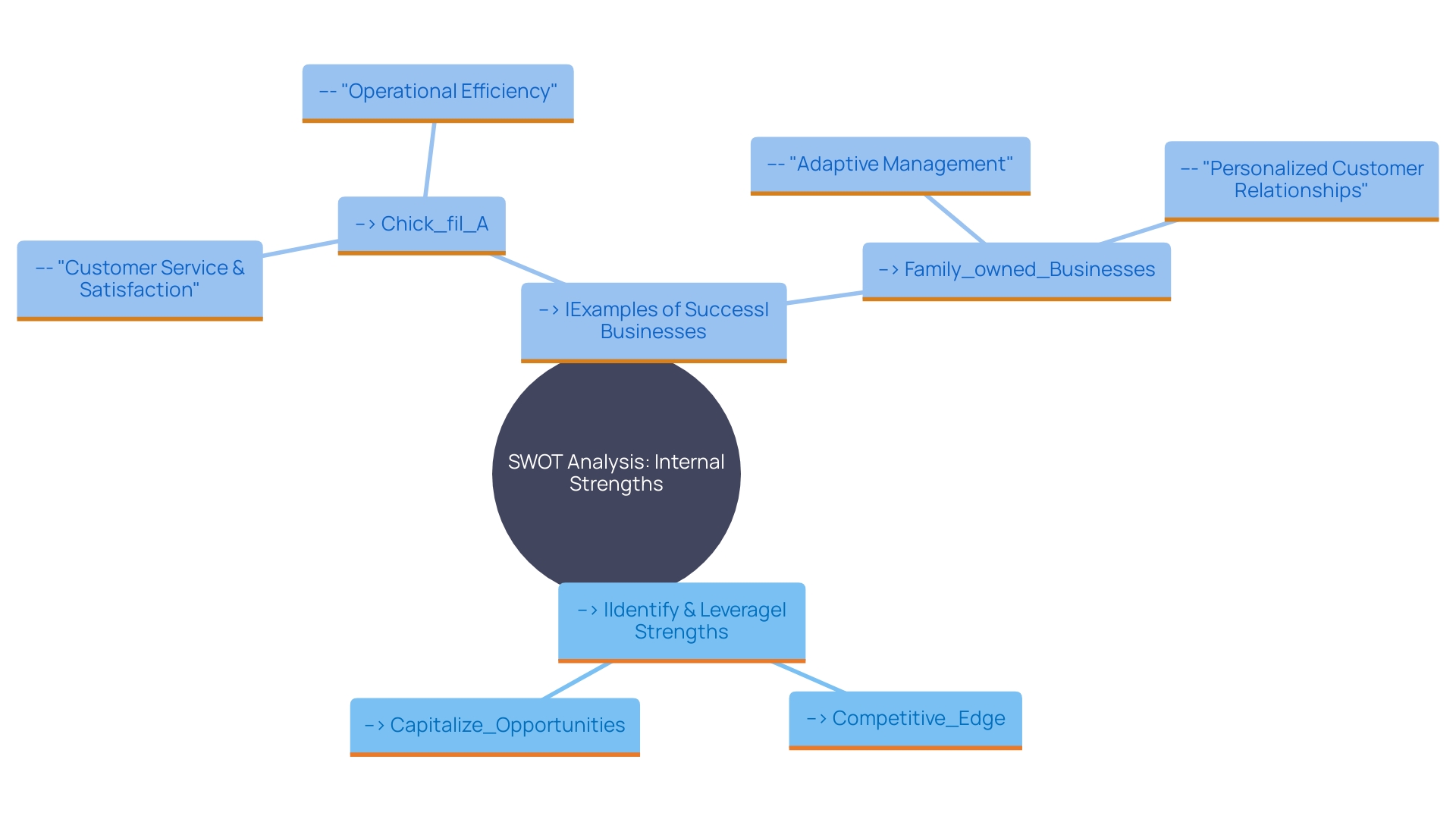
Identifying Weaknesses
When assessing internal vulnerabilities that could impede the progress of your business, it's crucial to be as meticulous as finance professionals are when calculating a sustainable growth rate. Recognize that just as growth should not outpace financial resources to avoid dilution of equity or debt accumulation, similarly, other vital resources should be scaled proportionately. Talent, know-how, processes, and even company culture must keep pace with growth.
If neglected, these can become critical bottlenecks, much like underfunding can. The gaps in capabilities and operating inefficiencies often dismissed as growing pains could cascade into quality issues and operational failures, depleting your resources further.
Consider the importance of strategic assets evident in successful business launches. Intellectual property, data, access to sales channels, a robust brand, a culture that fosters innovation, strategic partnerships, and essential technologies—are each indispensable in their own right. Their presence or absence should be measured against your ambition.
Failing to leverage these assets effectively can be as detrimental as any financial shortfall. Rapid expansion without solid underpinnings in these areas may lead to suboptimal outcomes, much like an unwise merger or acquisition where incompatibilities erode rather than enhance value.
The market's pulse, evidenced by data such as GDP trends or insolvency rates, should inform strategy adjustments. For instance, stagnant economic indicators or rising business bankruptcies, as reported by sources like Statistics Canada or Eurostat, might signal the need for more cautious growth strategies. The pragmatic CFO observes these external signals, weighs them against internal capabilities, and manages growth not just as a pursuit of opportunities but as a calibrated strategy informed by a continuous learning process, where the adaptability and resilience of the business model are put to test.

Identifying Opportunities
Exploring external environments is vital for identifying growth opportunities, such as engaging with emerging markets where banking is blossoming. In regions like India and Indonesia, the burgeoning banking sector is a testament to an array of opportunities, given that many individuals are experiencing financial services for the first time. These demographic trends, coupled with the increasing disposable income of these populations, signal promising prospects for economic engagement and expansion.
Capitalizing on emerging markets requires astute analysis and a solid understanding of the competitive landscape. One must evaluate the strength and strategies of existing players, along with a calculation of potential revenue based on market demand. Identifying these opportunities involves a rigorous, weighted assessment of various criteria ranging from market size to competition, leading to a prioritized shortlist of promising countries.
Considering the robust growth rates in emerging markets, outpacing those of developed economies, and the potential of markets like Brazil, where economic indicators suggest an upcoming surge in consumer confidence, there is a compelling case for business expansion into these regions. However, such ventures should not overlook the importance of local legal and cultural nuances to ensure successful market entry and sustained growth.
Identifying Threats
Understanding and managing the array of external threats to your business is a critical component of preserving your company's health and competitive edge. Among these threats are formidable competitors carving dominant paths in the market, instability from economic fluctuations, and shifting regulatory landscapes that necessitate agile responses.
Take the sobering episode involving The Weather Network's parent company, Pelmorex Corp. The company's president, Nana Banerjee, woke to a nightmare of system failures that sapped confidence and rattled operations. Such vulnerabilities expose the importance of robust, real-time crisis management strategies.
Similarly, the tech sector has witnessed the stark consequences of inadequate risk management. CrowdStrike's system update hiccup, which led to a staggering 8.5 million Windows machines crashing simultaneously, highlights the perils of software vulnerabilities and the absolute necessity for meticulously tested updates.
Moreover, the swift exploitation of software vulnerabilities by threat actors like CACTUS demonstrates that risk can manifest almost instantaneously. This reality demands that organizations stay ever-vigilant and ready to counteract such threats with expedient security measures and proactive monitoring.
Amidst diverse economic climates, businesses also face the challenge of navigating slow growth periods, such as the recent experiences in the UK economy. They illustrate the need for flexibility and foresight in strategic planning to survive and thrive under uncertain economic conditions.
Key industry voices like Andrea Davis and Doug Eichler stress the urgent need for robust emergency plans and a dedication to reimagining customer engagement strategies, highlighting the prevalent risks of complacency and customer confusion.
Backing up the qualitative insights with quantitative data, reports have shown that strategic competitor analysis can provide a distinctive advantage. Whether through astute SEO tactics or in-depth market research informed by comprehensive competitive analysis, businesses equipped with data can craft strategies to outmaneuver competitors and appeal to their target demographics effectively.
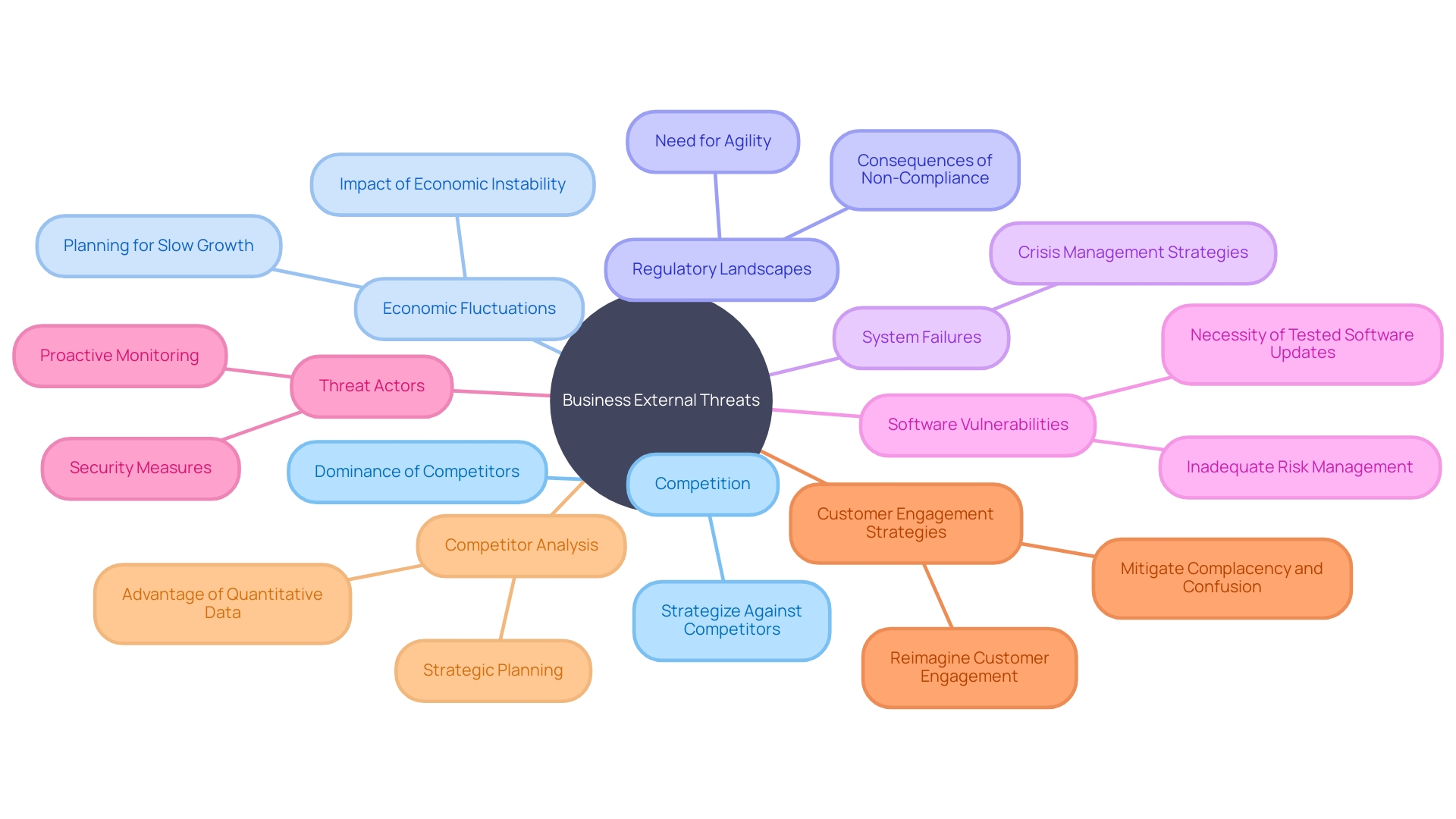
Creating a SWOT Matrix
Creating a SWOT matrix is a pivotal step in evaluating the strategic position of your business. Utilizing this framework allows for a comprehensive view, delineating internal strengths and weaknesses against external opportunities and threats. Through this matrix, you're equipped to see the intricate interplay among these factors, efficiently structuring the foundation from which to prioritize and act.
Developing this visual tool aids in identifying core competencies such as robust technological infrastructure, a well-trained workforce, or a strong financial footing—elements that give your business an edge over the competition. Conversely, it lays bare the weaknesses that might be roadblocks, whether operational inefficiencies, resource limitations, or other vulnerabilities.
The SWOT matrix also sheds light on external prospects that could be harnessed, such as market expansion, technological advancements, or shifts in consumer behavior. At the same time, it alerts to potential risks looming on the horizon—be it from new regulations, increased competition, or economic volatility.
To contextualize its potency, consider the tale of Kodak, a titan in its industry, whose creation of the digital camera revealed both an unprecedented opportunity and a glaring internal weakness in their inability to adapt quickly. A well-structured SWOT matrix would not only have highlighted the digital camera as an innovation leap but also their sluggish reaction—providing crucial insights for strategic realignment.
For swift absorption of complex information, the SWOT matrix is crafted for immediate comprehension. This clarity is instrumental for stakeholders and decision-makers, guiding fruitful discussions and leading to strategy creation that aligns with the organization’s objectives and the market's reality. Indeed, the SWOT matrix is not merely an evaluative device but a strategic compass guiding businesses toward informed actions for sustainable growth and competitiveness.
Prioritizing Findings
Prioritizing the outcomes of a SWOT Analysis demands a precise understanding of how each element can drive your company forward. It involves more than recognizing internal strengths and weaknesses, or external opportunities and threats; it requires delving deeper into the business context—anticipating how socio-cultural, economic, and technological shifts could serve as catalysts for growth or potential stumbling blocks.
A practical example of strategic prioritization is discerning the sequence of operational paths. A business wanting to streamline processes could begin by optimizing sales and later, penetrate deeper into the customer base. This approach exemplifies the value of following specific growth paths, such as enhancing customer experience.
Customer experience, in this regard, is about the impression customers form upon interacting with your products and services, which impacts satisfaction and brand loyalty.
Analyzing indicators—such as project completion rates, adherence to timelines, and client satisfaction—helps in identifying core issues and pinpointing opportunities that can significantly boost productivity. An invigorated focus on executing these indicators can create a competitive advantage that is both quantifiable and qualitatively felt by customers.
Moreover, the integration of strategy and innovation is essential. As numerous Fortune 500 companies have demonstrated, innovations must be strategically aligned with the company's growth objectives and distinctive strengths. In practice, this means ensuring every innovative initiative complements the business’s overarching strategic priorities.
The insights and success stories from professionals across industries, including those recognized for their significant contributions, echo these principles. They exemplify the effectiveness of connecting academic research to practical applications—a process that uncovers the most crucial opportunities for development.
In essence, a meticulous SWOT Analysis that ranks findings by their potential impact is akin to an intricate puzzle of business strategy. It's about creating a harmonious picture where each piece, from value drivers like customer satisfaction and efficiency to innovation aligned with strategic priorities, contributes to a comprehensive and future-proof business strategy.
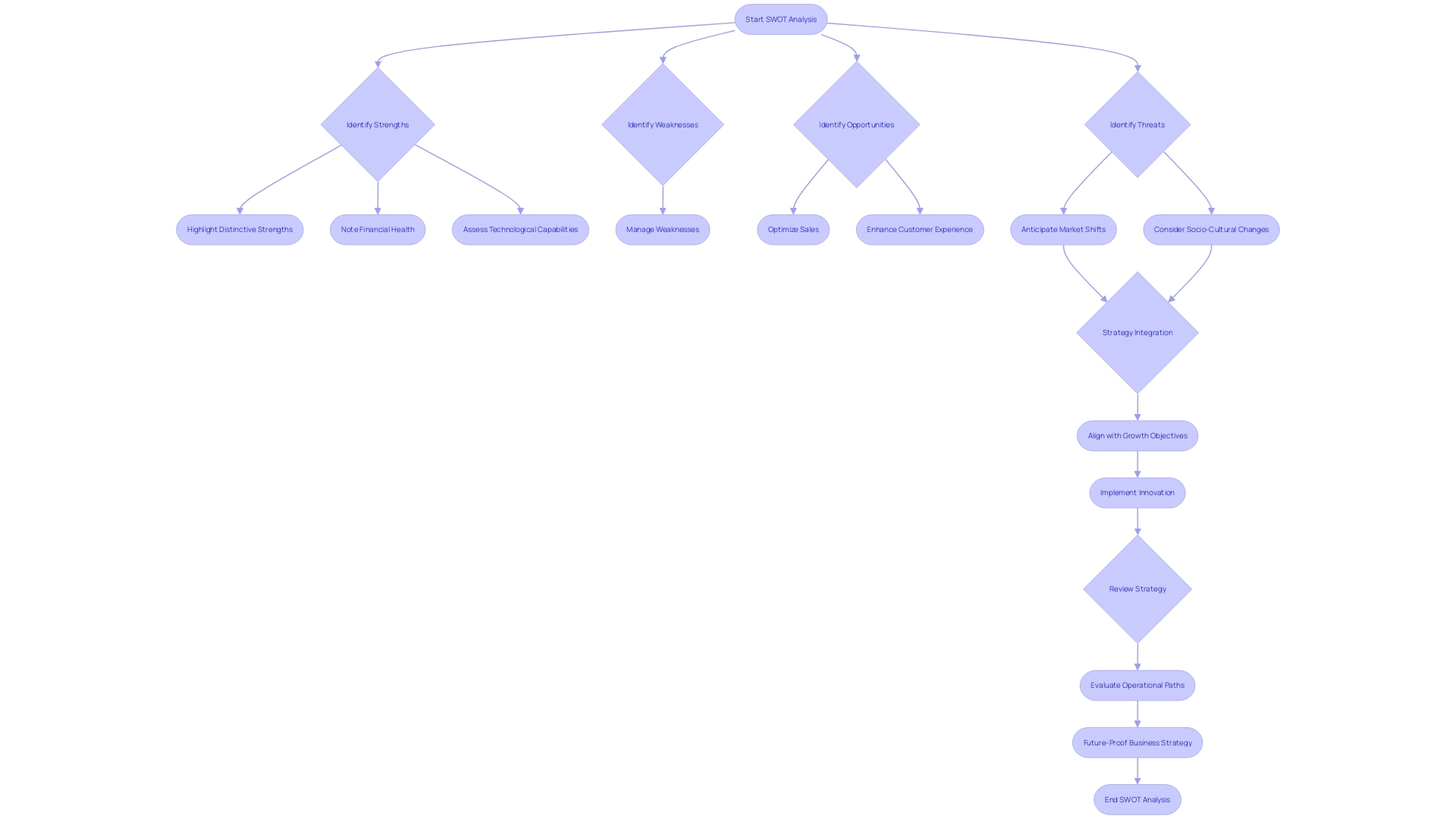
Developing a Plan
Generating and prioritizing opportunities is integral to strategic growth, yet having a roadmap to execute on those opportunities is crucial. This demands a strategic blueprint that sets forth precise, actionable steps. Taking a cue from industry leaders and innovative entrepreneurs, it's clear that an effective action plan encompasses not only what goals are to be achieved but also the specific initiatives required to reach them.
For instance, the founders of Custom Neon recognized an untapped market potential and crafted a plan harnessing their combined expertise in e-commerce and social media marketing to establish their brand. Similarly, IBL Group, with its deep-rooted entrepreneurial ethos, developed a balanced innovation portfolio responsive to various categories, ensuring sustainability alongside growth. This approach aligns with the reality that successful business transformations are an ongoing journey, as emphasized by the principles of the 'unfreeze-change-refreeze' model, but adjusted to reflect the continuous nature of modern business evolution.
Strategic Solution Partners exemplifies this continuous transformation by offering bespoke operational solutions in the hospitality sector, ensuring their planning is adaptive to each clientele's nuanced needs. The Albemarle County's Broadway Blueprint initiative illuminates another aspect of strategic execution by translating the Phase 1 study's findings into actionable interventions aimed at enhancing economic vitality and community involvement. Here, the engagement of a wide array of stakeholders was crucial in drafting recommendations for diverse communal needs.
The Government of Ontario further underscores the importance of tailored action plans by channeling investments into local businesses to foster job creation and provincial competitiveness in the global market.
An action plan must also account for valuation—an element critical during instances of inheritance, divorce, or tax-related business evaluations. Evidently, the journey from opportunity identification to execution is complex and necessitates diligent planning, constant adjustment and meticulous implementation to capitalize on the most promising opportunities and steer the organization towards success.
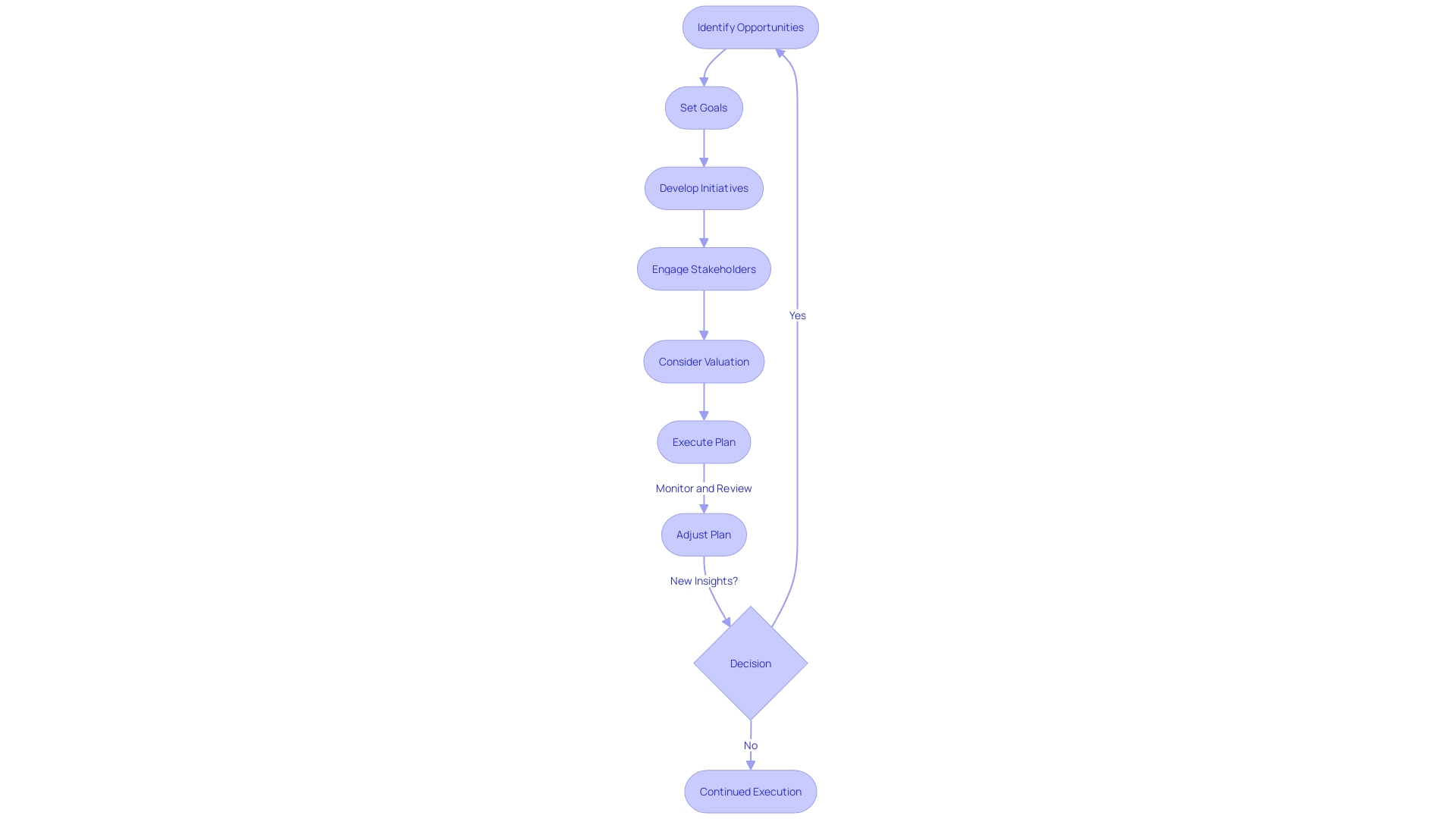
Implementing the Plan
Creating and implementing a marketing strategy is akin to setting out on an uncharted expedition. Initially, you may be faced with a gamut of frameworks, but simplicity and practicality should guide your course. The essence lies in identifying the intended recipients of your message—'customers' in a broad sense—and crafting a message tailored to resonate with them.
- Consider a straightforward marketing plan, answering pivotal questions like the audience you aim to reach and the message you want to deliver.
- Reframe the classical marketing mix by focusing on the actionable elements suitable for your organization's online and offline presence.
- Draft a cohesive roadmap that nudges an organization from marketing inertia to a dynamic cycle of strategy and optimization.
Real-world examples like Levi Strauss exemplify setting tangible objectives, such as water use targets that align with local environmental stresses. They demonstrate balancing ambitious goals with structured milestones and assessing supply chain risks to devise practical solutions. Progress is reviewed regularly, and the plan adjusts based on these insights.
- Apply Levi Strauss's approach of defining your baseline, setting goals cognizant of resource constraints, and charting your trajectory through interim objectives and necessary adjustments.
Addressing your organization's needs, this plan is built on understanding your capabilities and ensuring internal reporting and oversight align with your goals. Effective project management is integral, evidenced by insights from enterprise resource planning (ERP) projects where factors like business size, complexity, and resource availability dictate the timetable for success. The need for accurate scheduling is paramount as it maintains project momentum and ensures alignment with broader strategic objectives.
- To facilitate this, employ targeted time management techniques to minimize stress and ensure an efficient progression towards your goals.
Embrace a strategy that gripes with reality, sculpting a path that is clear, measurable, and attuned to the organization's pulse, offering a beacon of guidance as you evolve your marketing acumen.
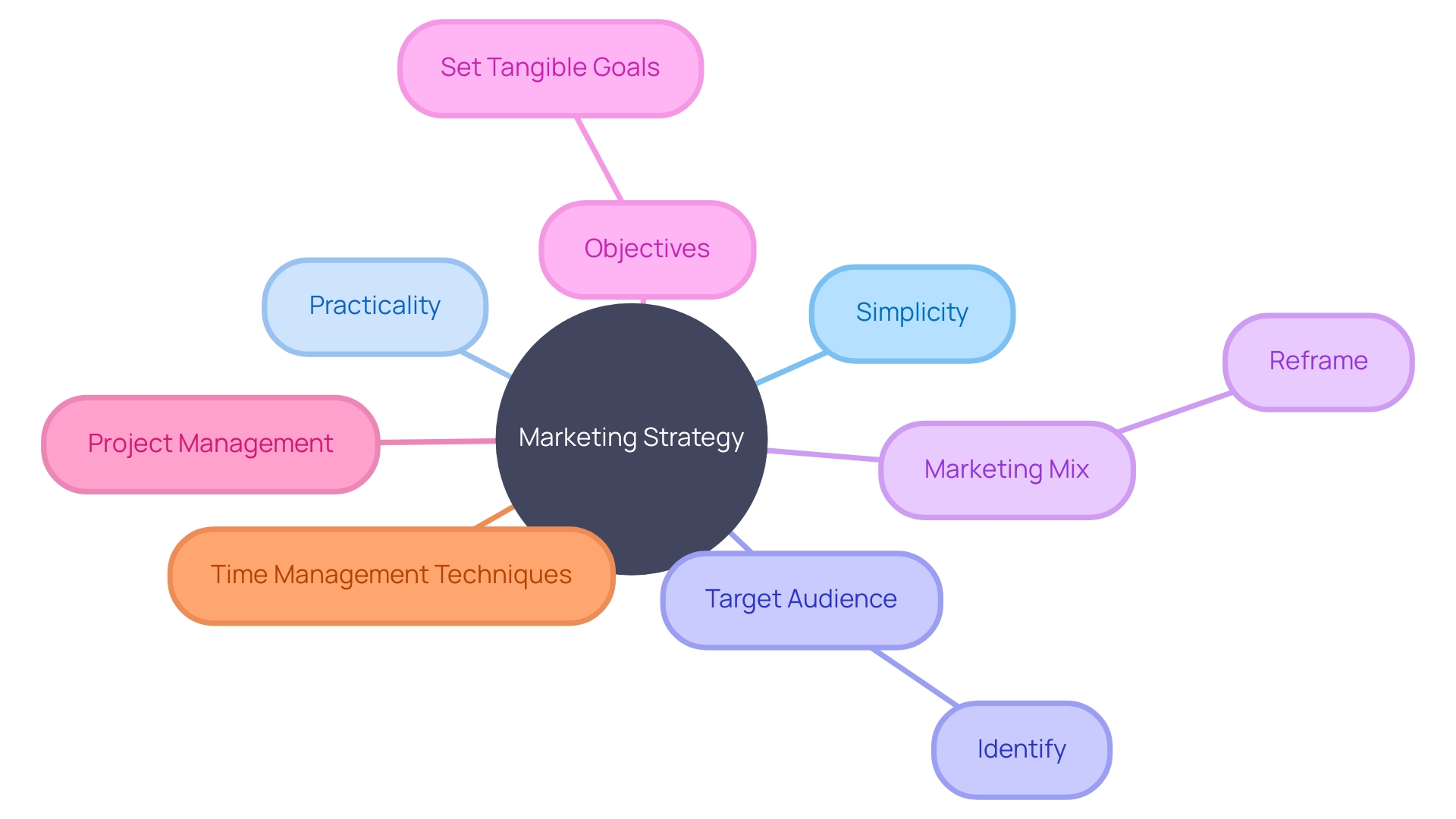
Practical Examples of SWOT Analysis Opportunities
Let's delve into the practical application of SWOT Analysis by examining how businesses utilize this framework to maximize opportunities. Spotify, the audio streaming behemoth, utilized a SWOT Analysis to position itself in the competitive music industry. Starting in Stockholm, the platform distinguished itself through a user-friendly interface and extensive music catalog.
It tackled its strengths by negotiating key licensing deals, thereby bolstering its library and user base, which has soared past 500 million active users and over 8 million artists.
Incorporating SWOT Analysis involves not just recognizing strengths but also acknowledging weaknesses within an organization. For instance, identifying potential shortcomings like budget constraints assists in crafting strategies to navigate these challenges effectively. It's essential to ask critical questions about vulnerabilities, including team culture or adaptability to change, to comprehensively define organizational weaknesses.
Moreover, a SWOT Analysis encourages a panoramic view of the business landscape. It's not just about immediate outcomes but the long-term trajectory as well. This analysis fosters enhanced communication and collaboration across departments, leading to a unified front in strategy execution and decision making.
The key here is to systematically evaluate internal capabilities and align them with external realities to develop an informed, actionable plan.
To echo the sentiments of industry experts, SWOT Analysis remains a cornerstone of strategic planning. It reveals a business's position relative to industry dynamics and equips decision-makers with insights to leverage their strengths, address any gaps, and anticipate future challenges. Particularly, startups can benefit from early SWOT assessments to establish a solid foundation for success and to navigate the complexities of the market.
In summary, SWOT Analysis, with its focus on strengths, weaknesses, opportunities, and threats, serves as a powerful tool that enables businesses to make well-informed decisions. It paves the way for organizations to capitalize on their unique advantages and external opportunities while proactively managing any internal shortcomings and external pressures.
Example 1: Expanding into New Markets
Spotify's journey from a simple idea to a global audio streaming leader illustrates the power of a well-implemented SWOT analysis. They identified a gap in the market for legal, user-friendly music streaming and tapped into this opportunity with clear strategic advantages: a broad music catalog and cutting-edge features. Their strengths were leveraged to engage over 500 million active users, turning untapped market segments into vast opportunities for growth and innovation.
Similarly, Travel Charme Strandhotel Bansin transformed its operations through technology, leading to enhanced guest experiences. They focused on their strengths as a family-friendly destination and maximized opportunities during peak vacation seasons. By combining high-quality service with strategic marketing, Travel Charme capitalized on their location, achieving substantial room occupancy rates and establishing themselves as a holiday favorite.
Primark's expansion from a Dublin-based store to an international retail giant echoes this sentiment. They always focused on providing everyday affordability and maintained this core philosophy through market-specific strategies that fueled their growth in 17 different countries. Their strategic analysis understood the need for preserving brand identity while exploring new opportunities.
These examples showcase how businesses can harness strengths, navigate weaknesses, address threats, and explore opportunities. Such comprehensive analyses support strategic decisions, driving remarkable growth against the backdrop of dynamic market conditions and diverse consumer preferences.
Example 2: Strategic Partnerships
Retail Business Services (RBS), collaborating with innovation platform MassChallenge, exemplifies the strategic partnership approach a technology startup may seek. RBS, serving notable grocery brands, works to align their technological ambitions with their partners' dynamic ideas, benefiting from innovation that transcends the common challenges within the grocery market. Similarly, JaneTech, an engineering firm from New York specializing in bespoke solutions for varied industries, including media and virtual reality, emphasizes diversity and inclusion while ensuring compatibility and performance across diverse customer platforms.
Recent partnerships, like that of RBS with MassChallenge, reveal the potential of strategic alliances. Bringing together different perspectives and expertise can lead to innovative solutions that may initially be conceived for a specific challenge but have broader applications, as demonstrated by RBS's experience.
Another narrative comes from JaneTech's partnership based on their foundational use of Docker, integral to their development strategy for producing lasting, relevant technology. It's a move resonating with industry trends towards sustainability and technological endurance, reflecting an understanding that successful partnerships hinge on more than transactional benefits—they must be nurtured through common goals and shared strategic visions.
These examples are underscored by the burgeoning interest in Silicon Valley's Enovix, a battery technology startup now contracted to fuel a leader in the mixed-reality market. This alliance exemplifies how startups can leverage innovative solutions to access new markets and offer insights into the symbiotic nature of startups and industry giants.
Echoing these sentiments are the insights from the latest statistical analyses, which suggest that the ability to navigate the 'chaos' of rapid scaling, as highlighted in Index Ventures' research, and the understanding of the dual nature of challenge and reward in starting a business are central to the tech startup journey. This backdrop of continuous innovation and collaboration is essential for any technology startup aiming to secure strategic partnerships that expand their market reach and enhance resource access.
Example 3: Digital Transformation
At the forefront of manufacturing innovation, the renowned Electronics Factory Erlangen exemplifies the power of digital transformation. By embracing advanced digitalization techniques, including the deployment of AI, digital twins, and IT/OT integration, this factory has catapulted its operations into a new era of productivity and sustainability. The people working at the Digital Enterprise are the vital force behind this shift, demonstrating the significance of a technologically adept and adaptive workforce.
German-based company aquatherm has also shown how industry-specific digital advancements—in their case, within the piping system manufacturing sector—can yield substantial benefits. Knowing that their polypropylene pipe systems for construction and building services hold ecological value, they have coupled their comprehensive services and technical acumen with a dedication to contributing to a more eco-friendly world, thus pushing the envelope for climate-conscious manufacturing practices.
The pervasive drive towards digitalization is undeniably reshaping the manufacturing landscape in the UK, as underscored by reports indicating that a staggering 96% of companies are deploying at least one cutting-edge technology. Energized by the collective desire to advance and adapt, UK manufacturers are responding to various drivers of change, from the economic pressures of energy optimization to the strategic shifts towards localized renewable energy sources. Conversely, smaller businesses face unique challenges with the complexity and costs associated with adopting digital processes.
Nonetheless, shared knowledge and successes from companies who lead by example serve as a beacon for others to follow, paving the way for a more resilient and efficient manufacturing sector.
Example 4: Diversification of Product Line
Understanding the motives which propel customers towards specific products, a visionary food and beverage enterprise discerned the increasing preference for wholesome sustenance. They embarked on an ambitious venture, uniting with experts in nutrition to expand their offerings to accommodate this rising demand. Drawing from their established brand, they infiltrated the market with a new, healthier selection of items, cognizant of the innate complexities such diversification entails.
Nevertheless, judicious planning and comprehensive market analysis illuminated the path forward, while collaborations with dieticians underscored their commitment to quality and consumer health, circumventing the potentially adverse impacts of product cannibalization. Illustrated by the vibrant adoption of specialty foods—now accounting for a significant 20% of total volume in retail dollars—the industry underscores an enduring shift towards high-quality, distinct foods with enduring growth. This strategic expansion is deftly evidenced by the likes of PepsiCo India's initiative to trial healthier oil blends in response to varied regional nutritional standards and public health advocacy, mirroring a global movement towards responsible consumption.
Such a pivot to healthier product lines not only aligns with consumer aspirations but harnesses the winds of a burgeoning sector, ensuring the company remains firmly on the growth trajectory.

Conclusion
In conclusion, a SWOT analysis is a powerful tool for businesses to assess their internal dynamics and external market conditions. By evaluating strengths, weaknesses, opportunities, and threats, organizations can make informed decisions and develop strategies for sustainable growth and competitiveness.
Through a step-by-step process, businesses can conduct a comprehensive SWOT analysis, identifying internal strengths and weaknesses. This helps capitalize on advantages and address areas for improvement. Considering external factors like industry trends and market shifts is equally important to identify opportunities and threats that need strategic management.
Creating a SWOT matrix provides a visual representation of the interplay between internal and external factors. This helps prioritize findings and lays the groundwork for informed decision-making and strategy development. Leveraging the insights gained from the analysis, businesses can generate actionable strategies that capitalize on strengths and mitigate weaknesses.
Practical examples demonstrate how businesses have used the SWOT framework to maximize opportunities. Companies like Spotify, Retail Business Services, and the Electronics Factory Erlangen have leveraged their strengths to position themselves in the market and embrace digital transformation. Strategic partnerships and diversification of product lines have also been effective approaches.
Overall, a SWOT analysis empowers businesses to navigate the complexities of the business landscape, make informed decisions, and drive sustainable growth. By leveraging strengths, addressing weaknesses, and anticipating challenges, organizations can adapt and thrive in a dynamic environment. It is a strategic blueprint that guides businesses towards success.




